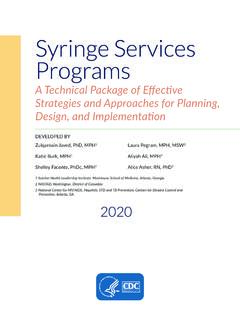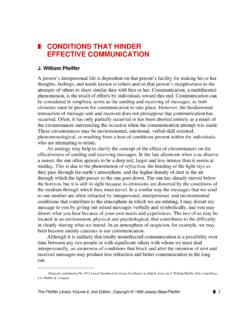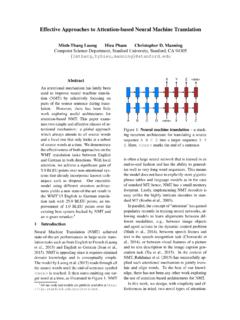Transcription of Thresholds for the cost–effectiveness of interventions ...
1 Policy & practice Thresholds for the cost effectiveness of interventions : alternative approaches Elliot Marseille,a Bruce Larson,b Dhruv S Kazi,c James G Kahnd & Sydney Rosenb Abstract Many countries use the cost effectiveness Thresholds recommended by the World Health Organization's Choosing interventions that are Cost effective project (WHO-CHOICE) when evaluating health interventions . This project sets the threshold for cost effectiveness as the cost of the intervention per disability-adjusted life-year (DALY) averted less than three times the country's annual gross domestic product (GDP) per capita.
2 Highly cost effective interventions are defined as meeting a threshold per DALY averted of once the annual GDP per capita. We argue that reliance on these Thresholds reduces the value of cost effectiveness analyses and makes such analyses too blunt to be useful for most decision-making in the field of public health. Use of these Thresholds has little theoretical justification, skirts the difficult but necessary ranking of the relative values of locally-applicable interventions and omits any consideration of what is truly affordable.
3 The WHO-CHOICE Thresholds set such a low bar for cost effectiveness that very few interventions with evidence of efficacy can be ruled out. The Thresholds have little value in assessing the trade-offs that decision-makers must confront. We present alternative approaches for applying cost effectiveness criteria to choices in the allocation of health-care resources. Brazil or US$ 27 per QALY gained in the United Republic Introduction of Tanzania represents good use of money for the national In public health, cost effectiveness analyses compare the costs health-care system?
4 And effectiveness of two or more health interventions with Three general approaches have been used to solve this effectiveness measured in the same units. When comparing problem: (i) Thresholds based on per capita national incomes;. interventions , the incremental cost effectiveness ratio (ICER) (ii) benchmark interventions and (iii) league tables. In re- the difference in costs divided by the difference in health cent years, the most common approach has involved the use effects is often used to express the result. of Thresholds based on per capita gross domestic product Estimates of costs, health effects and ICERs provide clear (GDP).
5 Under this approach which has been promoted by guidance to policy-makers in three situations: (i) when the the World Health Organization's Choosing interventions that health-effect target is specified by policy-makers and the aim of are Cost effective (WHO-CHOICE) project3 an intervention the cost effectiveness analysis is to minimize the expenditure that, per disability-adjusted life-year (DALY) avoided, costs needed to achieve that target; (ii) when a budget constraint less than three times the national annual GDP per capita is is specified by policy-makers and the aim is to maximize the considered cost effective , whereas one that costs less than health benefits while keeping expenditure within budget; and once the national annual GDP per capita is considered highly (iii) when policy-makers have specified an explicit standard cost effective .
6 Or threshold for what should be considered cost effective . In this article, we argue that the current Thresholds based In all three cases, the analysts completing the cost effective - on per capita GDP have major shortcomings as guides for ness analysis cannot objectively make a recommendation to policy-makers, since each of the available approaches has policy-makers without prior decisions by policy-makers on substantial weaknesses. We then discuss that a new con- health-effect or cost targets or Thresholds . Without reference sensus should be reached on a process for evaluating the to such decisions, the cost effectiveness analysis cannot fully cost effectiveness of health interventions that places ICERs orient policy-makers to the range of options that might be in the context of other, local policy and programme options, good investments.
7 Including funding sources. We focus on cost effectiveness For example, compared with no vaccination, routine and ignore other criteria for policy decisions, such as equity, quadrivalent human papillomavirus vaccination combined ethics and political feasibility. We proceed from the premise with catch-up vaccination to protect against cervical diseases that evidence-based economic evaluations are vital additions in Brazil was found to have an ICER of 450 United States to public policy decisions which would otherwise largely dollars (US$) per quality-adjusted life-year (QALY) reflect political, ideological and/or bureaucratic concerns.
8 We In the United Republic of Tanzania, compared with no treat- focus on the relative merits of different ways of distinguishing ment, post-exposure prophylaxis for rabies was found to have what constitutes an acceptable level of cost effectiveness and an estimated ICER of US$ 27 per QALY However, on the limitations of the widely used national-income-based how does one decide whether US$ 450 per QALY gained in approach. a Health Strategies International, 555 Fifty-ninth Street, Oakland, California, 94609, United States of America (USA).
9 B Center for Global Health and Development, Boston University, Boston, USA. c Division of Cardiology, San Francisco General Hospital, San Francisco, USA. d Institute for Health Policy Studies, University of California San Francisco, San Francisco, USA. Correspondence to Elliot Marseille (email: (Submitted: 5 March 2014 Revised version received: 27 October 2014 Accepted: 26 November 2014 Published online: 15 December 2014 ). 118 Bull World Health Organ 2015;93:118 124 | doi: Policy & practice Elliot Marseille et al. Cost effectiveness Thresholds Thresholds Box 1.)
10 Widely differing cost effectiveness ratios of programmes considered very cost . effective according to WHO-CHOICE criteria The most pervasive threshold was initially promoted by the Commission In Zambia, three public health strategies have dramatically differing cost effectiveness ratios on Macroeconomics and Health and compared with doing nothing: adopted in The world health report 2002 Expansion of access to insecticide-treated bednets for malaria prevention: this intervention and by WHO-CHOICE. This threshold has an estimated cost of 29 international dollars (I$) per disability-adjusted life-year (DALY).














